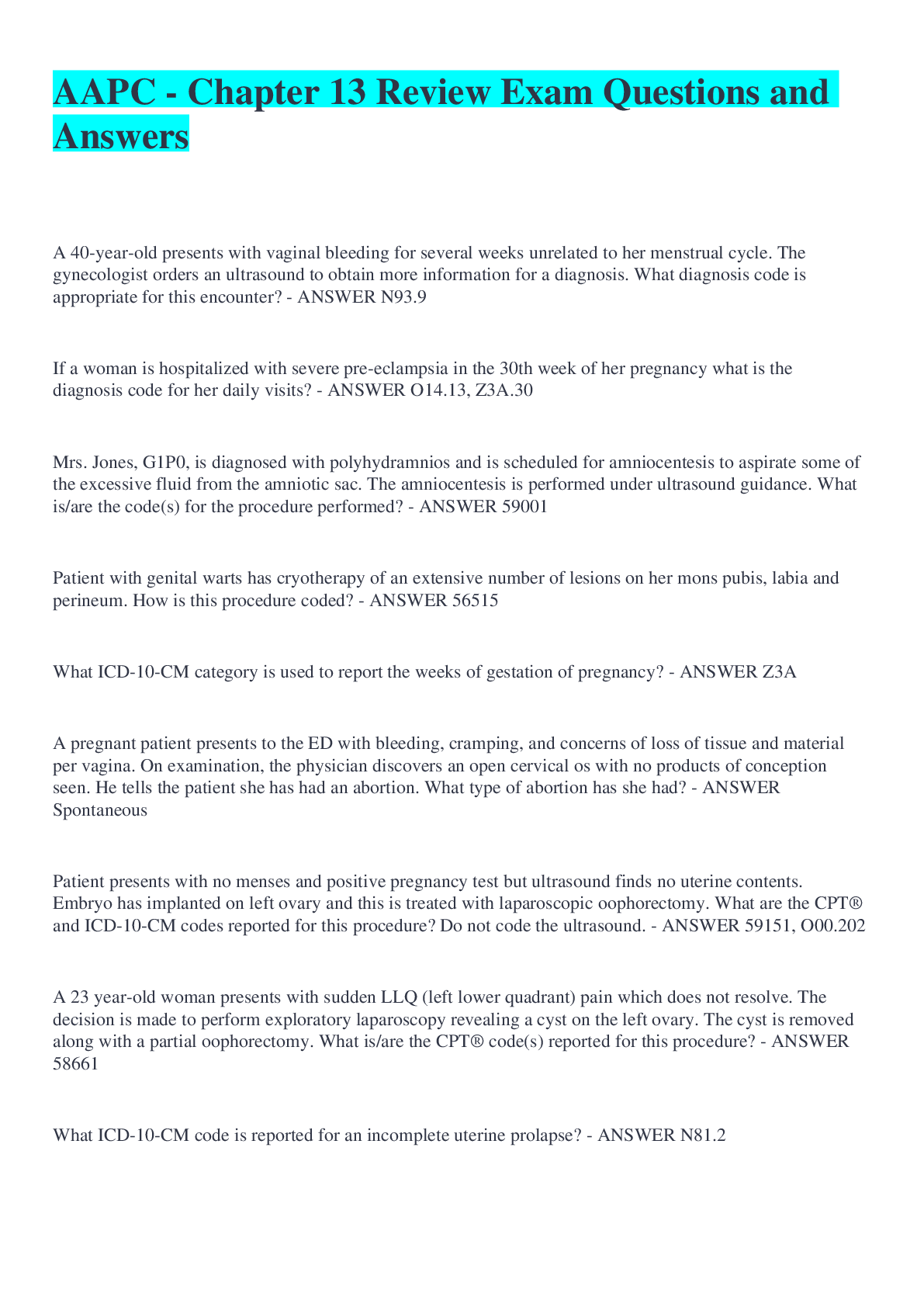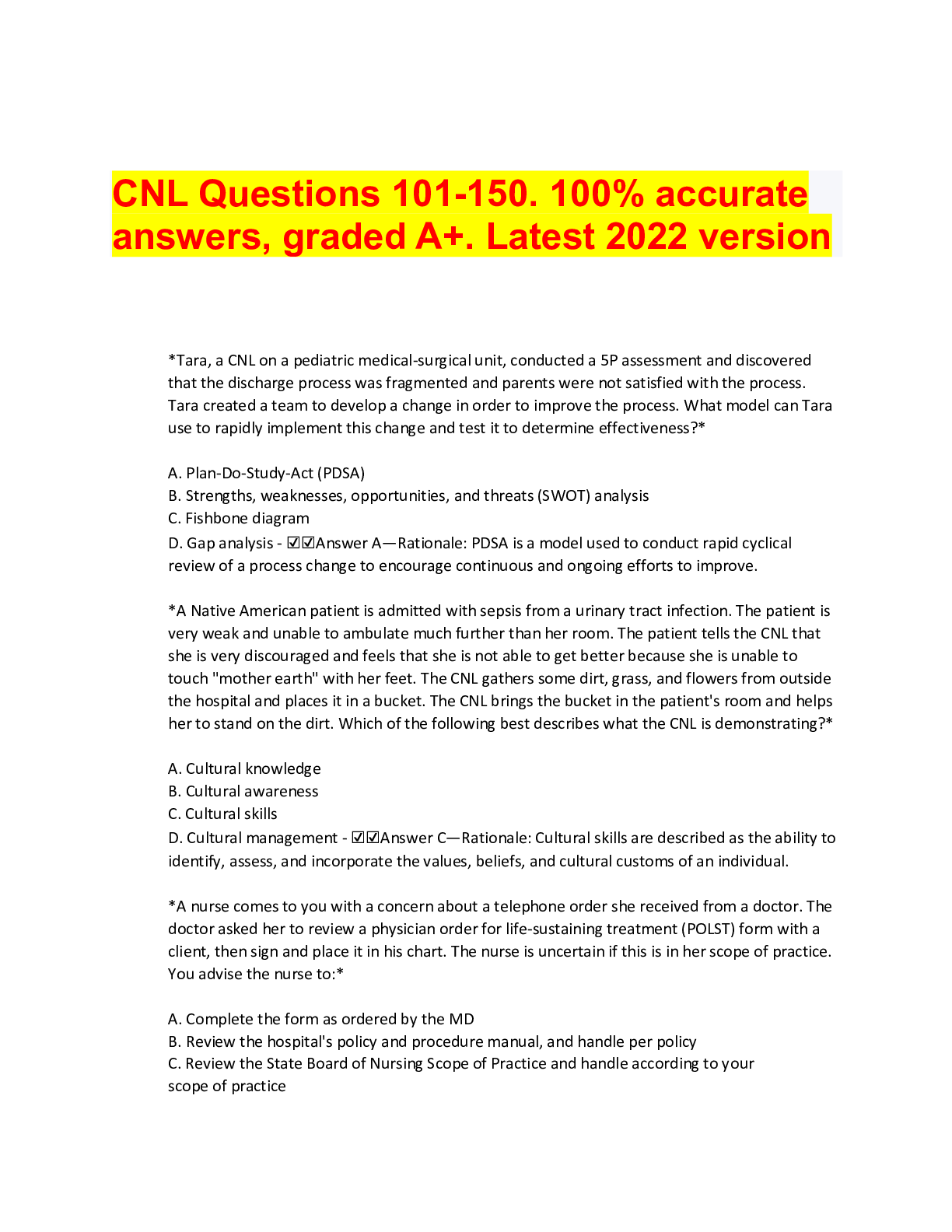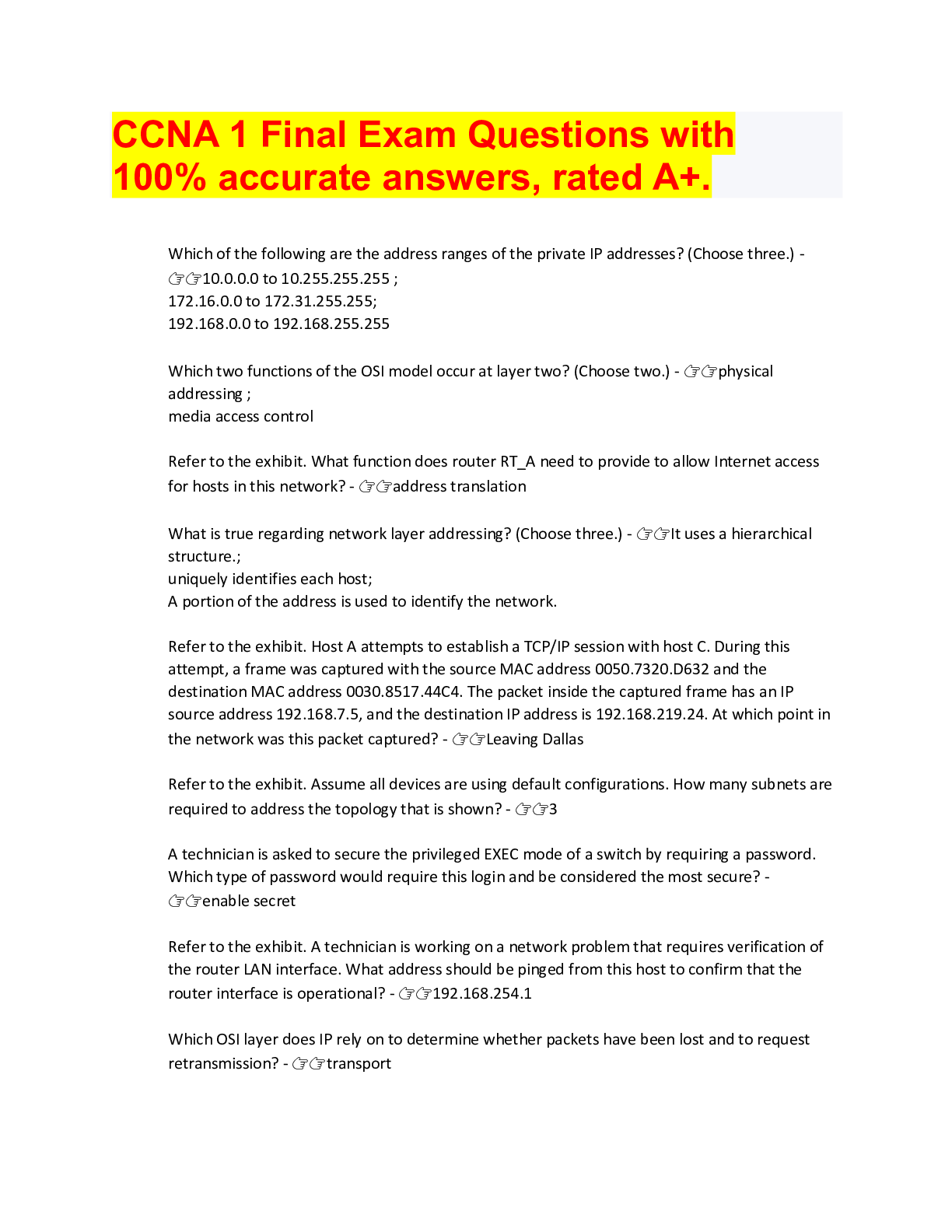*NURSING > QUESTIONS & ANSWERS > CSEP-CPT Theory Exam Question with accurate answers, 100% Accurate, rated A+ (All)
CSEP-CPT Theory Exam Question with accurate answers, 100% Accurate, rated A+
Document Content and Description Below
CSEP-CPT Theory Exam Question with accurate answers, 100% Accurate, rated A+ Define the sagittal plane. What movements occur within this plane? - ✔✔-- Divides the body along the midline int... o left and right halves - flexion/extension Define the frontal plane. What movement occurs within this plane? - ✔✔-- Separates the body into anterior (front) and posterior (back) portions - abduction/adduction & side flexion Define the transverse plane. What movement occurs within this plane? - ✔✔-- Separates the body into superior (toward the head/upper body) and inferior (away from the head) portions - internal/external rotation & horizontal flexion/extension & supination/pronation Define supination - ✔✔-Lying face up Define pronation - ✔✔-Lying face down Functions of skeletal system - ✔✔-- provide form, structure and movement of body - protection of internal organs - attachment point for muscles - RBC's produced in bone marrow - warehouse for calcium, iron, and energy (fat) How many bones in skeletal system? - ✔✔-206 What is the axial and appendicular skeleton? - ✔✔-Axial Skeleton: runs along body's midline axis (skull, ribs, vertebral column) Appendicular Skeleton: the limbs, pelvic girdle, and shoulder girdle What are the 5 classifications of bones? What are some characteristics of each? - ✔✔-1) Long Bones - grow the most throughout life; hollow medullary cavity for bone marrow 2) Short Bones - as long as they are wide (ie. carpal bones in wrist) 3) Flat Bones - very thin in one direction, no medullary cavity (ie. skull bones, hip bones) 4) Irregular Bones - no regular shape (ie. vertebrae, sacrum, coccyx) 5) Sesamoid Bones - formed after birth inside tendons; help protect from strains at the joint (ie. patella) Types of joints and their characteristics: - ✔✔-1) Synovial Joints: - most common, have a fluid-filled gap between bones allowing for free ROM & lubrication 2) Fibrous Joints: - where bones are very tightly joined; little to no movement (ie. teeth into sockets) 3) Cartilaginous Joints: - where two bones meet cartilage; provide small flexibility due to gel-like cartilage How many muscles are there in the human body? - ✔✔-~700 named What are the three types of muscle? Are the voluntary or involuntary? - ✔✔-- smooth and cardiac muscle: involuntary - skeletal muscle: voluntary What is the sarcolemma? What is it's function? - ✔✔-- the cell membrane of a muscle fibre - conducts electrochemical signals that stimulate muscle cells What is the function of transverse tubules (T-tubules)? - ✔✔-Help carry electrochemical signals into the middle of the muscle fiber What are myofibrils? What are they made up of? - ✔✔-The contractile structures of a muscle fiber - made up of protein fibers arranged into sarcomeres (functional unit of a muscle fiber) What are thick and thin filaments composed of? - ✔✔-Thick: bonded units of myosin protein Thin: three proteins - actin, tropomyosin, and troponin What is the Sliding Filament Model? - ✔✔-Actin filaments interact with myosin filaments appearing to "slide" over each other - results in shortening of sarcomere and hence contraction of the muscle fiber What is a motor unit? - ✔✔-A single motor neuron and the muscle fibers it innervates - the less muscle fibers a motor neuron innervates, the more fine motor control that region has Difference between ligaments and tendons? - ✔✔-Ligaments: fibrous connective tissue connecting bone to bone Tendons: tough fibrous connective tissue connective muscle to bone What are the two main phases of contraction? - ✔✔-1) Isometric Contraction - no visible shortening of muscle, tension is increasing - sarcomere is shortening but elastic components parallel to muscle fibre are stretching 2) Isotonic Contraction - visible shortening of muscle, tension remains constant What is Bowditch's Law? (The "all-or-nothing" law) - ✔✔-MU's are either activated all the way or not at all - stimulus threshold What is the Henneman size principle? - ✔✔-Number of MU's activated is proportional to stimulus received - smaller MU's activated first moving to larger MU's at highest threshold Characteristics of Slow-Twitch Oxidative Fibers (Type 1) - ✔✔-- Structure: small diameter, high capillary density, large amount of mitochondria Metabolic: - depend on aerobic cellular respiration (lots of ATP but slower because of length of oxidative pathway) - Slowest contraction speed b/c of decreased myosin ATPase activity - high myoglobin levels - store energy as triglycerides - Function: endurance (very fatigue resistant), postural muscles (low stimulation threshold), lowest power production Characteristics of Fast Oxidative fibers (Type 2a) - ✔✔-- Structure: largest diameter, high capillary density, LOTS of mitochondria, moderate amount of stored glycogen Metabolic: - depends on aerobic conditions (uses glucose +oxygen) but can switch to anaerobic (PCr) - fast contractility due to high myosin ATPase activity - myoglobin density relatively high Function: - second fiber type recruited; moderate power production - walking muscles (moderately fatigue resistant ~<30 mins) - high intensity (ie. sprinting) but for no longer than 1 min. Characteristics of Fast Glycolytic fibers (Type 2x) - ✔✔-Structure: intermediate diameter, low capillary density (very little mitochondria or myoglobin), high glycogen storage (anaerobic) Metabolic: - anaerobic: creatine phosphate pathway and glycogenolysis - VERY high myosin ATPase activity; fastest contractility - last fiber type to be recruited Function: - quick burst power activities (highest power production, lowest fatigue resistance; seconds - <1 min) - weight lifting, sprints etc. What parts of the body act as: fulcrum, effort force, lever, and load in a biomechanical system? - ✔✔- Lever: bone that the muscle moves Effort Force: the muscle Fulcrum: the joint Load: object being moved What are the majority of levers in the body? What does this look like? - ✔✔-Third Class Levers - fulcrum is at end of lever - effort is between fulcrum and load - load at other end of the lever Define: - Antagonistic pairs of muscles - agonist muscles - synergist muscles - antagonist muscles - stabilizers - global stabilizers - ✔✔-- Antagonistic pairs = opposing muscle groups around joints - Agonist muscles = primary movers, that work with synergist (helper muscles) to generate force required for movement - Antagonist muscles = opposing muscles that relax and lengthen - Stabilizers = muscles that prevent unwanted movement at the joints - Global Stabilizers = stabilize trunk/"core" to create more solid foundation for movement Describe the Anaerobic Alactic Energy System: - ✔✔-- high energy phosphate system - dominant at onset of movement; high rate of energy supply - anaerobic - lasts 0-15 seconds - does not directly produce lactic acid - provides ATP from ATP stores, and through converting PCr into usable ATP Describe the Anaerobic Lactic Energy System: - ✔✔-- dominant source for high intensity PA lasting longer than 10s. - lasts 15-120s. - uses glycolysis (glucose from CHO to ATP) - produces lactic acid; side rxn that keeps supply going when mitochondria cannot keep up with activity demand - produces metabolic by-products that lead to fatigue (lactate threshold) - system dominates with powerful bursts of energy What is the Lactate Threshold? - ✔✔-When lactate and metabolic by-products accumulate with intense activity using the anaerobic metabolism pathway - lactate + hydrogren (H+) + ADP + Pi + CO2 + H2O - reaches threshold where they accumulate exponentially and inhibit muscle performance - usually ~70% VO2max Describe the Aerobic Energy System: - ✔✔-- active during all PA, but provides the most energy for lower intensity PA of longer durations (over two mins.) - inertia in oxygen supply chain can meet demands of working muscles - active cellular respiration to convert food energy into ATP - only by-products are CO2 and H2O (seen in sweat and heavy breathing) - carbohydrates and fats primary fuel What is "Oxygen Deficit"? - ✔✔-The lag in oxygen consumption at the onset of aerobic activity, O2 does not yet meet demands of the activity - continues until body reaches steady-state What is "Oxygen Debt"? - ✔✔-Elevated oxygen uptake that remains for several minutes during recovery from activity - aka. Elevated Post-Exercise Oxygen Consumption (EPOC) - elevated for longer with more intense PA Where does the spinal cord start? Where does it end? - ✔✔-Starts at the medulla oblongata, and finishes by separating into bundles of individual nerves (cauda equina) What is white and grey matter? - ✔✔-White Matter: main conduit of nerve signals throughout body Grey Matter: integrates responses into stimuli Describe the somatic and autonomic divisions of the PNS: - ✔✔-Somatic: consciously controlled - stimulates skeletal muscles Autonomic: subconscious control that regulates cardiac, and visceral muscles, and glandular tissue What are the 3 divisions of the autonomic nervous system? - ✔✔-- sympathetic: fight or flight - parasympathetic: rest and digest - enteric: regulates digestion and digestive organs How many cranial nerves are there? How many spinal nerves? - ✔✔-Cranial = 12 Pairs (I to XII) Spinal = 31 Pairs - 8 cervical pairs - 12 thoracic pairs - 5 lumbar pairs - 5 sacral pairs - 1 coccygeal pair What is the intervertebral foramen? - ✔✔-The hole that spinal nerves exit the spinal cord from between vertebrae What are the two valve types in the heart? - ✔✔-AV (atrioventricular valves) - separate atria and ventricles Semilunar valves - separate ventricles from pulmonary artery/aorta What is the pulmonary circuit? What is the systemic circuit? - ✔✔-Pulmonary: Right atrium receives deoxygenated blood, pumps to right ventricle which ejects blood to pulmonary artery to lungs Systemic: left atrium receives oxygenated blood from the lungs, pumps to left ventricle and ejects to aorta for circulation What structures does air pass through when inhaled? - ✔✔-- mouth or nose - nasal cavity - pharynx - larynx - trachea - bronchi - secondary bronchi - tertiary bronchi - bronchioles - alveoli What are the physiological adaptations to aerobic training? - ✔✔-- increased: CO, SV, blood volume, hematocrit, heart volume, LV thickness, blood flow to lungs, size/number mitochondria, mitochondrial enzymatic activity, capillarization (angiogenesis), increased fat oxidation - decreased peripheral resistance What are some physiological adaptations to resistance training? - ✔✔-- increased: muscle strength (both actual muscle and neural adaptations), muscle power, balance and coordination (increased activation of MU's, decreased co-contraction of antagonists), BMR, lean tissue mass, muscle endurance, motor performance, insulin sensitivity - decreased: %BF, low back pain, sarcopenia & osteoporosis, insulin concentration How long does it take to see adaptations related to strength training? - ✔✔-Initial 2-6 weeks: changes in force production (neurological adaptation as brain gets better at coordinating contraction/MU recruitment), no changes in muscle size 4-6 weeks: can see increase in muscle size, further strength gains (more than neural adaptations) - hypertrophy: increase in total # of contractile protein, # & size of myofibrils, amount of connective tissue 6-12 Months: secondary phase of neural adaptations, further strength gains, hypertrophy, improved bone mineral density (site-specific), increased size and strength of ligaments & tendons Benefits of flexibility training: - ✔✔-- can increase flexibility - limits tendency of ligaments and tendons to shorted and restrict movement - helps prevent injuries - improves posture (& reduces lower back pain) - improves balance during movement What is a normal heart rate range? - ✔✔-About 60-80bpm Describe Stroke Volume: - ✔✔-Volume of blood pumped per beat - will increase with activity intensity until plateau at ~50% VO2max (after this HR increases) Describe blood pressure. Does it change during exercise? - ✔✔-Pressure exerted on the walls on the blood vessels - exhibits efficiency of blood flow through the CV system - during exercise, systolic BP increases but diastolic BP shows very little change What is a MET? - ✔✔-MET = metabolic equivalent/the ratio of energy consumption to a reference metabolic rate - conventionally set at 3.5 ml O2/kg/min - level of METs is the multiplier of intensity above rest (ie. 3 METs is 3x intensity of rest) What is the equation for a MET? - ✔✔-1 MET = 3.5 x weight (kg) / 200 How do you calculate calories from METs? - ✔✔-Calories = METs x 3.5 x weight (kg) / 200 x time (minutes) What are the main determinants of health? - ✔✔-- gender - genetics - environment (incl. access to health services and social environment) - education - employment and working conditions - income & social status What is the Active Living Philosophy? - ✔✔-Recognizes the health benefits of all kinds of PA. Beyond seeing exercise as something separate from daily living. Encourages regular PA as a way of life. Reduced sedentary time as a focus. Essential for helping those who are inactive to change little by little and find activities that are useful, pleasurable and satisfying What are the MET ranges for light, moderate, and vigorous PA? - ✔✔-Light = 1.5-3.0 METs for adults (1.5-4.0 for children) Moderate = 3.1-5.9 METs for adults (4-6.9 for children) Vigorous = >6.0 METs for adults, >7.0 METs for children What are health-related fitness components? - ✔✔-- body composition - aerobic fitness - musculoskeletal fitness (strength, endurance, balance) What are performance-related fitness components? - ✔✔-- agility - speed - power - reaction time - motor skill performance/coordination What general percentage of Canadian adults do not meet guideline levels of PA? Canadian youth? - ✔✔- Adults: ~15% meet 150mins/week minimum Youth: as few as 7% meet guideline (60 mins MVPA at least 6 days a week) What are the health risks of sedentary behaviour? - ✔✔-- Increased risk of: obesity, glucose intolerance, type II diabetes, cardiovascular disease, premature mortality - unfavourable posture - lower self-esteem - cognitive decline How much activity is required to break up sedentary time? - ✔✔-As little as 90 seconds every 15-20 minutes can significantly improve blood glucose, triglycerides, and insulin levels (compared to uninterrupted sitting) How much PA is required daily to mitigate an otherwise sedentary lifestyle (ie. desk job) - ✔✔-60-75 minutes per day can mitigate some risks - high amount of TV viewing still has risks What is the optimal daily movement pattern for humans? - ✔✔-Intermittent sitting and standing, frequent light-intensity movement, and purposeful bouts of moderate-vigorous intensity PA What are the 24-Hour Movement Guidelines for adults (18-64)? - ✔✔-- minimum 150 mins MVPA per week (bouts of 10 minutes or more) - strengthening activities 2x per week - 7 to 9 hours of sleep per night - reduced screen time (limit TV to 2 hours) ** same for older adults (65+) What are the 24-Hour Movement Guidelines for youth (5-17)? - ✔✔-- at least 60 mins MVPA per day - strengthening activities 3x per week - light PA accumulated for several hours (unstructured, play) - 9 to 11 hrs. sleep for 5-13 year olds - 8-10 hrs. sleep for 14-18 year olds - no more than 2 hours recreational screen time What is the minimum recommended daily CHO intake? - ✔✔-120-130g - for adequate glycogen storage and glucose needs of the brain What is the generally accepted daily protein intake level for adults? What about the level for maximizing protein turnover? - ✔✔-1.0-1.4 g/kg/day Optimal 1.6 g/kg/day - intake every 3/4 hrs. is recommended with each meal containing ~20-40g (varies by person) What vitamins are fat soluble? - ✔✔-A, D, E, K What is the ideal omega-3 to omega-6 ratio? Why? - ✔✔-1:4 - 1:6 Because both fats compete for the use of similar enzymes as part of their metabolism, and omega-6 has many pro-inflammatory markers (typical Western diets typically have ratio of 1:10 - 1:12) What is accepted % of fat in daily diet? - ✔✔-30-40% - depending on total carbohydrate intake Difference between vitamins and minerals? - ✔✔-Vitamins are ORGANIC substances made by plants or animals. Minerals are INORGANIC elements absorbed by plants through the soil and water. What are the 3 major minerals? What is their function? - ✔✔-Calcium: strong bones & teeth, maintenance of bone mass Magnesium: helps energy production, supports healthy heart, artery and muscle function Potassium: helps maintain healthy BP What are the symptoms of iron deficiency? - ✔✔-- loss of endurance - chronic fatigue - high exercise HR - low power - frequent injury - recurring illness - loss of interest in exercise - irritability What are they key messages for overall nutritional well-being given by Canada's Food Guide? - ✔✔-- have plenty of vegetables and fruit - eat protein foods - choose whole grains - make water the drink of choice - be mindful of eating habits - cook more ofte [Show More]
Last updated: 2 years ago
Preview 1 out of 49 pages

Buy this document to get the full access instantly
Instant Download Access after purchase
Buy NowInstant download
We Accept:

Reviews( 0 )
$12.00
Can't find what you want? Try our AI powered Search
Document information
Connected school, study & course
About the document
Uploaded On
Mar 14, 2023
Number of pages
49
Written in
Additional information
This document has been written for:
Uploaded
Mar 14, 2023
Downloads
0
Views
120

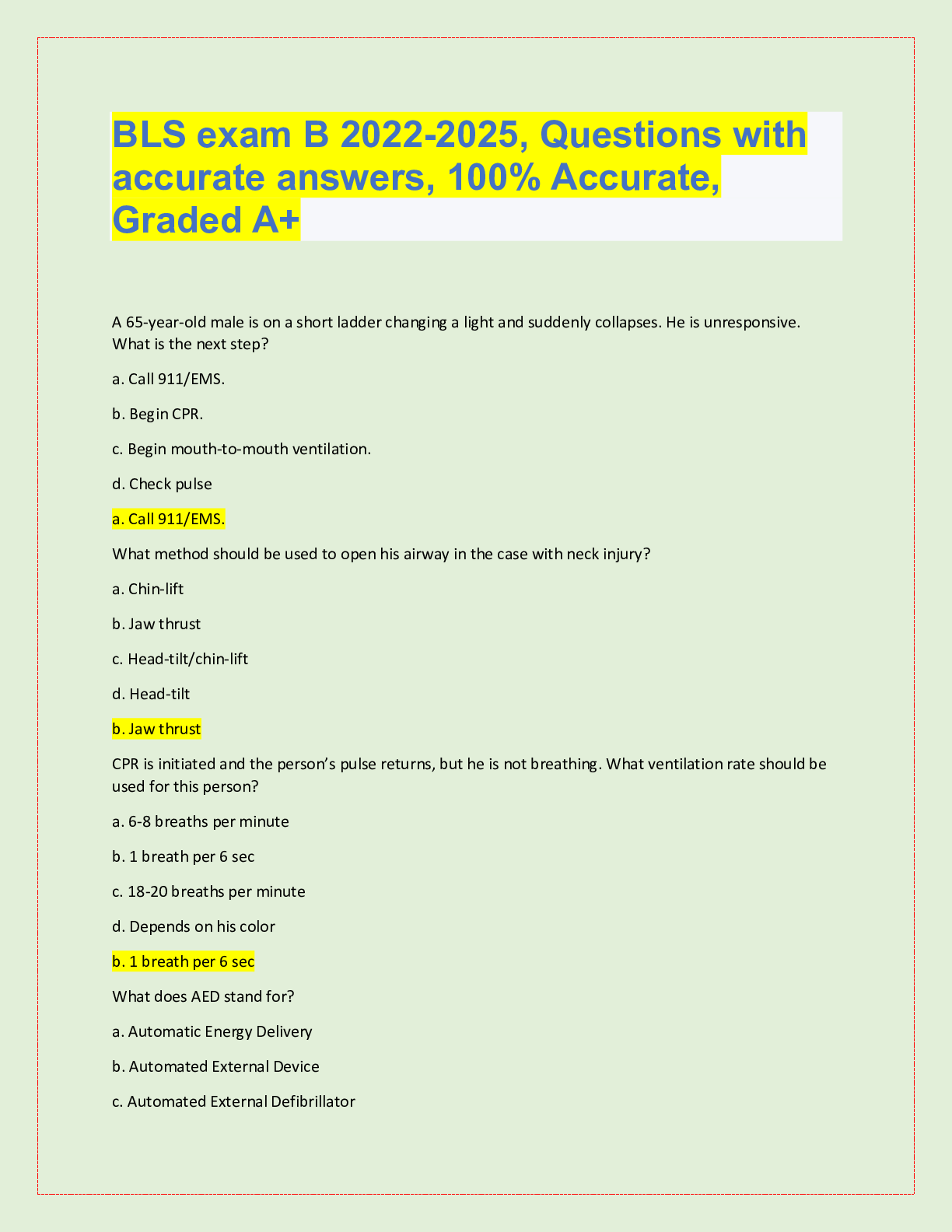











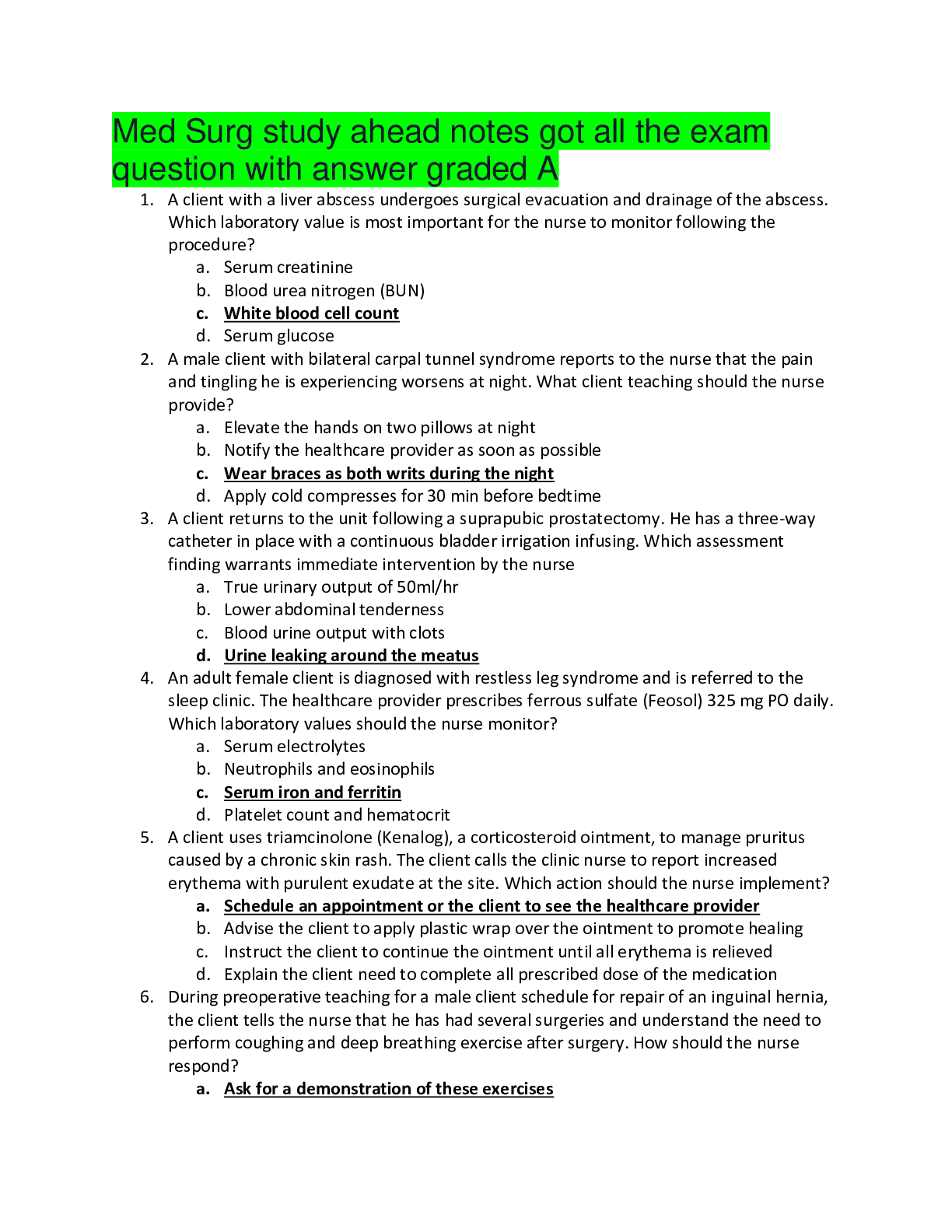
.png)



